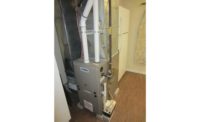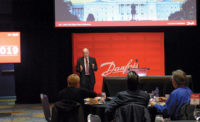The U.S. Department of Energy (DOE) is investing up to $6 million in research and design to lay the groundwork for more geothermal heating and cooling systems at federal facilities.
The two-year effort will be led by the energy department’s Oak Ridge National Laboratory in Tennessee, which will be assisted by three other national laboratories, researchers at two universities, and other partners.
The project is intended to improve the tools used to design and model geothermal systems, help researchers better understand the properties of the ground at different levels of stratification, and assess the effects of groundwater flow on the performance of geothermal heat exchangers (GHEs), among other goals. Researchers will also study the performance of existing federal geothermal systems.
The project is part of the Biden Administration’s push for carbon-neutral federal facilities. The administration’s goal is to have a 50% reduction in emissions at federal facilities by 2032 and zero emissions by 2045.
“Scaling up deployment of geothermal heating and cooling technology on federal sites will help reduce costs and energy demand, ultimately saving taxpayer dollars and leading by example to decarbonize our economy,” said Kelly Speakes-Backman, the DOE’s principal deputy assistant secretary for energy efficiency and renewable energy, in announcing the project.
There are currently ground-source heat-pump geothermal systems at a number of federal facilities.
At the Army’s Ft. Polk in Louisiana, a geothermal system cools and heats more than 4,000 military housing units, and reduced electricity demand, during a summertime peak, by 43%, the DOE said. At Camp Lejeune in North Carolina, a Marine Corps base, geothermal cut energy use for nearly half of the family housing units by about 33%, the DOE said.
The project comes out of the Federal Geothermal Partnership, a joint effort by the Geothermal Technologies Office and the Federal Energy Management Program.
Ultimately, said the DOE, the results of the work will guide officials as they consider installing geothermal systems at various federal properties. The plan is to focus particularly on properties run by the defense and state departments, the National Park Service, the National Aeronautics and Space Administration (NASA), and the General Services Administration, the DOE said.
Dr. Jeffrey Spitler, a professor of mechanical engineering at Oklahoma State University, will lead the efforts there. Spitler has done extensive research on ground-source heat pumps and developed software used to design geothermal systems. His and OSU’s role, Spitler said, will include improving the software and investigating existing federal systems.
“I’m excited to be working on design tools and system designs for large, district-scale ground-source heat pump systems,” Spitler said via email. “These systems can take advantage of load diversity and make a significant difference in energy usage and emissions.”
Dr. James M. Tinjum, an associate professor of civil and environmental engineering at the University of Wisconsin-Madison, said understanding the hydrothermal properties of the ground is important in designing efficient geothermal systems. Tinjum is heading up UW’s part of the project, which will involve drilling and testing to study underground conditions.
“The ground is normally assumed to be homogeneous in thermal-response testing analysis and GHE simulation/design tools,” Tinjum wrote in an email. “However, the ground is commonly stratified through the borehole depth, with layers of different geologic material with varying thermal properties and hydrogeological conditions.”
Pointing to recent research, Tinjum added that temperatures within a geothermal system’s borehole can vary significantly, which should be accounted for when a GHE is sized.
The other partners on the project are the National Renewable Energy Laboratory, the Lawrence Berkeley National Laboratory, the Pacific Northwest National Laboratory, the Illinois State Geological Survey, and the International Ground Source Heat Pump Association.






Report Abusive Comment